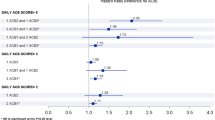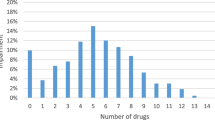Abstract
Purpose
Potentially inappropriate medications (PIMs) are associated with falls, hospitalization, and cognitive decline. Few studies have investigated the association between PIMs related to cognitive impairment (PIMCog) and mortality in dementia or mild cognitive impairment (MCI).
Methods
This was a retrospective observational study. Patients diagnosed with MCI or dementia (DSM-IV criteria) presenting to a tertiary-referral memory clinic from 2013 to 2019 were eligible. The primary outcome was all-cause death. Secondary outcomes were vascular death and non-vascular death. The primary exposure variable of interest was PIMCog, defined as any medication in the Beers 2015 or STOPP criteria, classified as potentially inappropriate for patients with cognitive impairment. Anticholinergic burden was measured using the anticholinergic cognitive burden (ACB) scale. Polypharmacy was defined as ≥ 5 medications. Cox proportional hazard models were used to calculate hazard ratios (HRs) and 95% confidence intervals (95% CIs).
Results
Four hundred eighteen patients were included (n = 261 dementia, n = 157 MCI). The median age was 79 (interquartile range [IQR] 74–82) and median follow-up was 809 days (IQR 552–1571). One or more PIMCog was prescribed in 141 patients (33.4%). PIMCog use was associated with all-cause mortality after adjustment for age, sex, dementia severity, Charlson’s Co-morbidity Index, chronic obstructive pulmonary disease, congestive cardiac failure, and peripheral vascular disease (HR 1.96, 95% CI 1.24–3.09). PIMCog use was associated with vascular death (HR 3.28, 95% CI 1.51–7.11) but not with non-vascular death (HR 1.40 95% CI 0.78–2.52).
Conclusion
PIMCog use in patients with cognitive impairment is high. It is independently associated with all-cause mortality and vascular death. This is a potential modifiable risk factor for death in this patient cohort. Further research is required to independently validate this finding.

Similar content being viewed by others
References
Fried TR, O’Leary J, Towle V, Goldstein MK, Trentalange M, Martin DK (2014) Health outcomes associated with polypharmacy in community-dwelling older adults: a systematic review. J Am Geriatr Soc 62(12):2261–2272
Park HY, Park JW, Song HJ, Sohn HS, Kwon JW (2017) The association between polypharmacy and dementia: a nested case-control study based on a 12-year longitudinal cohort database in South Korea. PLoS ONE 12(1):e0169463
Lai SW, Lin CH, Liao KF, Su LT, Sung FC, Lin CC (2012) Association between polypharmacy and dementia in older people: a population-based case-control study in Taiwan. Geriatr Gerontol Int 12(3):491–498
Boustani MCN, Munger S, Maidment I, Fox C (2008) Impact of anticholinergics on the aging brain: a review and practical application. Aging Health 4:311–320
Salahudeen MS, Duffull SB, Nishtala PS (2015) Anticholinergic burden quantified by anticholinergic risk scales and adverse outcomes in older people: a systematic review. BMC Geriatr 25(15):31
Koyama A, Steinman M, Ensrud K, Hillier TA, Yaffe K (2014) Long-term cognitive and functional effects of potentially inappropriate medications in older women. J Gerontol A Biol Sci Med Sci 69(4):423–429
Fox C, Richardson K, Maidment ID, Savva GM, Matthews FE, Smithard D et al (2011) Anticholinergic medication use and cognitive impairment in the older population: the medical research council cognitive function and ageing study. J Am Geriatr Soc 59(8):1477–1483
Myint PK, Fox C, Kwok CS, Luben RN, Wareham NJ, Khaw KT (2015) Total anticholinergic burden and risk of mortality and cardiovascular disease over 10 years in 21,636 middle-aged and older men and women of EPIC-Norfolk prospective population study. Age Ageing 44(2):219–225
Ruxton K, Woodman RJ, Mangoni AA (2015) Drugs with anticholinergic effects and cognitive impairment, falls and all-cause mortality in older adults: a systematic review and meta-analysis. Br J Clin Pharmacol 80(2):209–220
Campbell NL, Perkins AJ, Bradt P, Perk S, Wielage RC, Boustani MA et al (2016) Association of anticholinergic burden with cognitive impairment and health care utilization among a diverse ambulatory older adult population. Pharmacotherapy 36(11):1123–1131
Carriere I, Fourrier-Reglat A, Dartigues JF, Rouaud O, Pasquier F, Ritchie K et al (2009) Drugs with anticholinergic properties, cognitive decline, and dementia in an elderly general population: the 3-city study. Arch Intern Med 169(14):1317–1324
Campbell NL, Boustani MA, Lane KA, Gao S, Hendrie H, Khan BA et al (2010) Use of anticholinergics and the risk of cognitive impairment in an African American population. Neurology 75(2):152–159
Gray SL, Anderson ML, Dublin S, Hanlon JT, Hubbard R, Walker R et al (2015) Cumulative use of strong anticholinergics and incident dementia: a prospective cohort study. JAMA Intern Med 175(3):401–407
Gray SL, Anderson ML, Hanlon JT, Dublin S, Walker RL, Hubbard RA et al (2018) Exposure to strong anticholinergic medications and dementia-related neuropathology in a community-based autopsy cohort. J Alzheimers Dis 65(2):607–616
Tan ECK, Eriksdotter M, Garcia-Ptacek S, Fastbom J, Johnell K (2018) Anticholinergic burden and risk of stroke and death in people with different types of dementia. J Alzheimers Dis 65(2):589–596
Ah YM, Suh Y, Jun K, Hwang S, Lee JY (2019) Effect of anticholinergic burden on treatment modification, delirium and mortality in newly diagnosed dementia patients starting a cholinesterase inhibitor: a population-based study. Basic Clin Pharmacol Toxicol 124(6):741–748
By the American Geriatrics Society 2015 Beers criteria update expert panel (2015) American Geriatrics Society 2015 updated beers criteria for potentially inappropriate medication use in older adults. J Am Geriatr Soc 63(11):2227–46. https://doi.org/10.1111/jgs.13702. Epub 2015 Oct 8. PMID: 26446832
Gallagher P, Ryan C, Byrne S, Kennedy J, O'Mahony D (2008) STOPP (Screening Tool of Older Person's Prescriptions) and START (Screening Tool to Alert doctors to Right Treatment). Consensus validation. Int J Clin Pharmacol Ther 46(2):72–83. https://doi.org/10.5414/cpp46072. PMID: 18218287
Xing XX, Zhu C, Liang HY, Wang K, Chu YQ, Zhao LB et al (2019) Associations between potentially inappropriate medications and adverse health outcomes in the elderly: a systematic review and meta-analysis. Ann Pharmacother 53(10):1005–1019
Tannenbaum C, Paquette A, Hilmer S, Holroyd-Leduc J, Carnahan R (2012) A systematic review of amnestic and non-amnestic mild cognitive impairment induced by anticholinergic, antihistamine. GABAergic and opioid drugs Drugs Aging 29(8):639–658
Zhong G, Wang Y, Zhang Y, Zhao Y (2015) Association between benzodiazepine use and dementia: a meta-analysis. PLoS ONE 10(5):e0127836
Dublin S, Walker RL, Gray SL, Hubbard RA, Anderson ML, Yu O et al (2015) Prescription opioids and risk of dementia or cognitive decline: a prospective cohort study. J Am Geriatr Soc 63(8):1519–1526
Delgado J, Jones L, Bradley MC, Allan LM, Ballard C, Clare L et al (2021) Potentially inappropriate prescribing in dementia, multi-morbidity and incidence of adverse health outcomes. Age Ageing 50(2):457–464
Cross AJ, George J, Woodward MC, Ames D, Brodaty H, Wolfe R et al (2017) Potentially inappropriate medication, anticholinergic burden, and mortality in people attending memory clinics. J Alzheimers Dis 60(2):349–358
Association AP (1994) Diagnostic and statistical manual of mental disorders. 4th Edition ed. Washington DC: Am Psychiat Asso
Mioshi E, Dawson K, Mitchell J, Arnold R, Hodges JR (2006) The Addenbrooke’s Cognitive Examination Revised (ACE-R): a brief cognitive test battery for dementia screening. Int J Geriatric Psychiatry 21:1078–85
Folstein MFFS, Mchugh PR (1975) Mini-mental state. A practical method for grading the cognitive state of patients for the clinician. J Psychiatr Res 12:189–98
Charlson MEPP, Ales KL, MacKenzie CR (1987) A new method of classifying prognostic comorbidity in longitudinal studies: development and validation. J Chronic Dis 40:373–383
JW N (2007) Antipsychotic medications: metabolic and cardiovascular risk. J Clin Psychiatry 68:8–13
International AsD (2020) Dementia statistics. Available from: https://www.alzint.org/about/dementia-facts-figures/dementia-statistics/#:~:text=There%20are%20over%2050%20million,will%20be%20in%20developing%20countries. Accessed 31 May 2021
Livingston G, Huntley J, Sommerlad A, Ames D, Ballard C, Banerjee S et al (2020) Dementia prevention, intervention, and care: 2020 report of the Lancet Commission. Lancet 396(10248):413–446
Cross AJGJ, Woodward MC et al (2017) Potentially inappropriate medication, anticholinergic burden, and mortality in people attending memory clinics. J ALzheimers Dis 60:349–358
Delgado JJL, Bradley MC, Allan LM, Ballard C, Clare L, Fortinsky RH, Hughes CM, Melzer D (2021) Potentially inappropriate prescribing in dementia, multi-morbidity and incidence of adverse health outcomes. Age and Aging 26(2):457–464
Kristensen RU, Nørgaard A, Jensen-Dahm C, Gasse C, Wimberley T, Waldemar G (2018) Polypharmacy and potentially inappropriate medication in people with dementia: A nationwide study. J Alzheimers Dis 63(1):383–94. https://doi.org/10.3233/JAD-170905. PMID: 29578483
Porter B, Arthur A, Savva GM (2019) How do potentially inappropriate medications and polypharmacy affect mortality in frail and non-frail cognitively impaired older adults? A cohort study. BMJ Open 9
Tan ECKEM, Garcia-Ptacek S, Fastbom J, Johnell K (2018) Anticholinergic burden and risk of stroke and death in people with different types of dementia. J ALzheimers Dis 65:589–596
Myint PK, Fox C, Kwok CS, Luben RN, Wareham NJ, Khaw KT (2015) Total anticholinergic burden and risk of mortality and cardiovascular disease over 10 years in 21,636 middle-aged and older men and women of EPIC-Norfolk prospective population study. Age Ageing 44(2):219–25. https://doi.org/10.1093/ageing/afu185. Epub 2014 Nov 27. PMID: 25430550; PMCID: PMC6287704
Gamble DT, Clark AB, Luben RN, Wareham NJ, Khaw KT, Myint PK (2018) Baseline anticholinergic burden from medications predicts incident fatal and non-fatal stroke in the EPIC-Norfolk general population. Int J Epidemiol 47(2):625–33. https://doi.org/10.1093/ije/dyx265. PMID: 29452356; PMCID: PMC6198932
Lockery JE BJ, Ryan J, Stewart AC, Woods RL, Chong TT, Cloud GC, Murray A, Rigby JD, Shah R, Storey E, Ward SA, Wolfe R, Reid CM, Collyer TA, Ernst ME (2021) ASPREE Investigator Group, ASPREE Investigator Group listed on www.aspree.org. A cohort study of anticholinergic medication burden and incident dementia and stroke in older adults. J Gen Intern Med. Accessed 30 May 2021.
Kachru N, Holmes HM, Johnson ML, Chen H, Aparasu RR (2020) Risk of mortality associated with non-selective antimuscarinic medications in older adults with dementia: a retrospective study. J Gen Intern Med 35(7):2084–2093
Zeng CDM, LaRochelle MR et al (2019) Association of tramadol with all-cause mortality among patients with osteoarthritis. JAMA 10:969–982
Schwertner E SJ, Garcia-Ptacek S, Johansson B, Nagga K, Eriksdotter M, Winblad B, Religa D (2019) Antipsychotic treatment associated with increased mortality risk in patients with dementia. a registry-based observational cohort study. J Am Med Dir Assoc 20(3):323–29
Schneider LSDK, Insel P (2005) Risk of death with atypical antipsychotic drug treatment for dementia: meta-analysis of randomized placebo-controlled trials. JAMA 294(15):1934–1943
Douglas IJ, Smeeth L (2008) Exposure to antipsychotics and risk of stroke: self controlled case series study. BMJ 337
Mittal VKL, Williamson D, Muralee S, Tampi RR (2011) Risk of cerebrovascular adverse events and death in elderly patients with dementia when treated with antipsychotic medications: a literature review of evidence. Am J Alzheimers Dis Other Demen 26(1):10–28
Taipale H, Koponen M, Tanskanen A, Lavikainen P, Tolppanen AM, Sund R, Hartikainen S (2017) Use of benzodiazepines and related drugs is associated with a risk of stroke among persons with Alzheimer’s disease. Int Clin Psychopharma 32(3):135–41
Author information
Authors and Affiliations
Contributions
Study concept: EB, JM, LK; Study design: EB, JM, LK; acquisition of data: all authors; analysis of data: EB, JM, LK; interpretation of data: EB, JM, LK; reviewing manuscript drafts: all authors; approval of final draft to be submitted for publication: all authors.
Corresponding author
Ethics declarations
Conflict of interest
The authors declare no competing interests.
Additional information
Publisher's Note
Springer Nature remains neutral with regard to jurisdictional claims in published maps and institutional affiliations.
Rights and permissions
Springer Nature or its licensor (e.g. a society or other partner) holds exclusive rights to this article under a publishing agreement with the author(s) or other rightsholder(s); author self-archiving of the accepted manuscript version of this article is solely governed by the terms of such publishing agreement and applicable law.
About this article
Cite this article
Buckley, E., Jonsson, A., Flood, Z. et al. Potentially inappropriate medication use and mortality in patients with cognitive impairment. Eur J Clin Pharmacol 78, 2013–2020 (2022). https://doi.org/10.1007/s00228-022-03410-2
Received:
Accepted:
Published:
Issue Date:
DOI: https://doi.org/10.1007/s00228-022-03410-2




